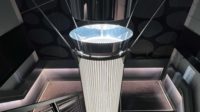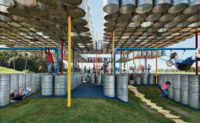Seattle's Olympic Sculpture Park
Former brownfield site reinvented as a connection between the city and the water’s edge.

To bridge a busy street and an active rail line, designers created a Z-shaped path and sculpted the earth.
Photo © Lara Swimmer

To bridge a busy street and an active rail line, designers created a Z-shaped path and sculpted the earth. To hold back 200,000 cubic yards of fill, engineers devised a mechanically stabilized earth retaining-wall system hidden behind overlapping and sloping precast panels.
Photo © Lara Swimmer

To bridge a busy street and an active rail line, designers created a Z-shaped path and sculpted the earth. To hold back 200,000 cubic yards of fill, engineers devised a mechanically stabilized earth retaining-wall system hidden behind overlapping and sloping precast panels.
Photo © Michael Dickter

To bridge a busy street and an active rail line, designers created a Z-shaped path and sculpted the earth. To hold back 200,000 cubic yards of fill, engineers devised a mechanically stabilized earth retaining-wall system hidden behind overlapping and sloping precast panels.

A buttress system stabilizes the aging timber-and-steel seawall along the shoreline. It was designed to also provide refuge for migrating salmon. Just beyond the end of the seawall, the designers have created a beach. The MSE retaining-wall system used to form the park’s contours is composed of layers of soil separated by geotextile fabric. Near the face of the MSE, the soil transitions to rock held in place by wire mesh.

A buttress system stabilizes the aging timber-and-steel seawall along the shoreline. It was designed to also provide refuge for migrating salmon. Just beyond the end of the seawall, the designers have created a beach. The MSE retaining-wall system used to form the park’s contours is composed of layers of soil separated by geotextile fabric. Near the face of the MSE, the soil transitions to rock held in place by wire mesh.
Photo © Benjamin Benschneider

A buttress system stabilizes the aging timber-and-steel seawall along the shoreline. It was designed to also provide refuge for migrating salmon. Just beyond the end of the seawall, the designers have created a beach. The MSE retaining-wall system used to form the park’s contours is composed of layers of soil separated by geotextile fabric. Near the face of the MSE, the soil transitions to rock held in place by wire mesh.
Photo © Bruce Moore




















